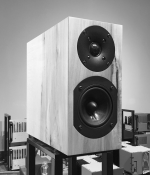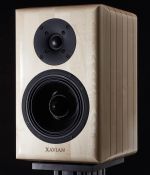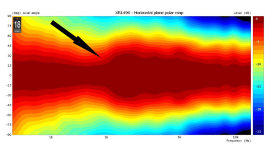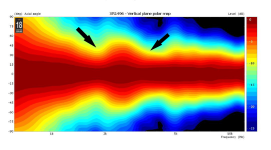"Below 2 kHz the vertical beamwidth is actually greater than the horizontal beamwidth! This is sometimes referred to as “pattern flip”. The vertical coverage pattern of the horn, which is supposed to be narrower than the horizontal coverage pattern, is now the broader coverage angle. In other words, the horizontal and vertical beamwidth have flipped with respect to which is greater and which is lesser. This is particularly noticeable when examining the directivity balloons"
//
//
Camplo did not say pattern flip, he said phase pattern flip. What does that mean to you?It surprises me that Dr. Geddes does not know the term, btw.
I think, and I responded as such, that camplo actually meant pattern flip. Never heard of phase pattern flip either, so I can't blame anyone for not knowing the term. I did expect a corrective response from Dr. Geddes though. In another tread I mentioned pattern flip recently and I assumed camplo was referring to that post. Maybe my mistake, if so I am sorry. I did share some interesting information though.Camplo did not say pattern flip, he said phase pattern flip. What does that mean to you?
In other words, the horizontal and vertical beamwidth have flipped with respect to which is greater and which is lesser. This is particularly noticeable when examining the directivity balloons"
//
As long as one stays in the 'hot spot', pattern flipt isn't (very) noticeable, but it becomes apparent when one moves off-axis.
Maybe I'm a bit obsessive in this regard, but I can't ignore the effect ('shift' in image) when I listen critically/attentively. Therefore it's not really an issue in clubs and at festivals.
Not necessarily because of pattern flip, but this is the worst horn in terms of imaging I've listened to. I even prefer a classic diffraction horn with sharp edges over this one.
Last edited:
A rule of thumb I picked up somewhere regarding avoiding excessive pattern flip, is to to keep the H:V angle ratio to 1.6 or lower.
Kinda explains the very common 1.5:1 ratio found in proaudio installs, i think.
Kinda explains the very common 1.5:1 ratio found in proaudio installs, i think.
At least the above image is called waist-banding and not pattern flip.Tbh I never expected these lobes (narrowing/widening) to be so noticeable.
View attachment 1192890View attachment 1192891
I wonder if the imaging problem was really due to the radiation pattern.
Regards
Charles
Regards
Charles
It's from Florian Schneider's own archive and posted in a Klangfilm group by the current owner of the Euronor Junior system.Ro808, whre did you find this picture (posted in a different forum) ? Thanks.
View attachment 1192919
Correct, shouldn't post while eating 😎At least the above image is called waist-banding and not pattern flip.
Really critical listening - based on years of concert visits, especially acoustic performances - feeds a frame of reference.I wonder if the imaging problem was really due to the radiation pattern.
Regards
Charles
While listening to the Ø Audio Icons, only acoustic music (band + singer) was played.
It was telling that our friend (a hobby musician, without much knowledge of audio) was able to point out very aptly what was wrong.
The waist-banding was portrayed almost holographically by the singer.
As if part of his voice was literally squeezed through a constriction ~ venturi effect.
The Ø Audio Icons were high on my 'must listen'-list, precisely because of the XR1496s. Aside from the horn artifacts, the system sounded pretty good.
However, because of that experience, that horn is an absolute no-go for me and as indicated earlier, I'm not the only one.
Last edited:
As long as one stays in the 'hot spot', pattern flipt isn't (very) noticeable, but it becomes apparent when one moves off-axis.
What do you mean exactly by saying "it becomes apparent when one moves off-axis"
I mean off-axis is a relative term und you should stay fair with respect to the intended listening space/window the speaker has been designed. When attending a HiFi show for example and you walk through the room maybe to have a closer look to a system then it becomes very probable that you leave the optimal listening window.A situation one wood maybe never face at home when the speaker have to cover only a few listening places.
My own experience is that the most obvious change of the listening impression was noticeable by lifting the listening position when using strong beaming round horns. When the ears are only 20-30cm higher in the vertical there was always considerable less HF and that was very reproducible with every different setup using these type of horns. And this had nothing to do with any pattern flip. Round horns have to pattern flip.
I would be happy if someone could explain what exactly happened when saying "i have heard a pattern flip".
For example, if you walk through the room while listening to music, which I do a lot, 'unnatural' shifts in the 'projected acoustic image' are clearly perceptible.
And once you have observed this phenomenon, it becomes easier and easier to detect it.
Of course there are all kinds of factors involved, such as the size of the horns and the H:V angle ratio - as Mark rightly pointed out.
And once you have observed this phenomenon, it becomes easier and easier to detect it.
Of course there are all kinds of factors involved, such as the size of the horns and the H:V angle ratio - as Mark rightly pointed out.
"Klangfilm group" - what does this mean ?It's from Florian Schneider's own archive and posted in a Klangfilm group by the current owner of the Euronor Junior system.
A group on FB in this case.
From my teenage years I've always had a soft spot for small monitor speakers such as these:


While I may switch to a fully horn loaded system at some point, a mini monitor on steroids is my current ideal.
This is also the reason why I prefer full range PA systems to any line array solution. The paper from which I extracted the plots of the QSC K12 illustrates the reason behind this. None of the 4 measured high end array systems even approaches the homogeneous radiation pattern of the K12.
From my teenage years I've always had a soft spot for small monitor speakers such as these:


While I may switch to a fully horn loaded system at some point, a mini monitor on steroids is my current ideal.
This is also the reason why I prefer full range PA systems to any line array solution. The paper from which I extracted the plots of the QSC K12 illustrates the reason behind this. None of the 4 measured high end array systems even approaches the homogeneous radiation pattern of the K12.
Last edited:
- Home
- Loudspeakers
- Multi-Way
- Is it possible to cover the whole spectrum, high SPL, low distortion with a 2-way?

